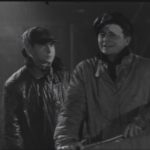 |
 |
 |
| Diana Joan Crawford |
Bogard Gary Cooper |
Claude Robert Young |
 |
 |
 |
| Ronnie Franchot Tone |
McGinnis Roscoe Karns |
Applegate Louise Closser Hale |
| Released by MGM | Directed by Howard Hawks Run time: 113 minutes |
||
Today We Live: Yesterday We Chat
“You take a lot of killing, doncha? C’mon.”
There’s a lot to like in Today We Live, but none of it’s in the right place. It’s the tragic love triangle stretched precipitously over a contest of male egos in a movie that’s both far too long and missing pieces all the same. The end result, despite coming from MGM’s Irving Thalberg, director Howard Hawks, and screenwriter William Faulkner, resembles less a bad movie but a defective product.
It begins as a Crawford picture, though, considering how much of it is expressing sadness and beating back against hope, it feels more like a Garbo film than one of Joan’s more fiery vehicles. Crawford’s British family has just lost their dad, and it looks like her brother Ronnie (Tone) and his best friend Claude (Young) are off to join the navy. Crawford’s Anne has been in puppy love with Claude for ages, and they promise to marry. A wrench is thrown into the mix: a boarder at their estate, Bogart, is played by Gary Cooper and utterly irresistible. Fearing the fact that her feelings for Claude are more of the sibling variety, she flees to work as a secretary on the war front. Bogart takes to the war as well, but is presumed dead after an accident and Anne sees that as the sign to marry Claude.
But, no, you don’t kill Gary Cooper off-screen, especially in a melodrama of this variety. Rumors of Bogart’s death were exagerated, and soon he’s at the front, too, gazing back and forth with Anne in the rain. He sees smiling Robert Young and decides to take him down a peg or two by showing him the dangers of being a bomber pilot. Jokes on him, though, as Young grins like an idiot and murders people. He takes Cooper on one of those boat rides which involves shooting a torpedo at a boat and someone going blind and a dovetail into the third act that we’ve all seen too many times before.
There’s a lot of movie here, but it’s like getting a steak that’s 90% T-Bone. There are words that are said, and eyes that are turned, and looks that are exchanged. But the words are mostly mush, often repeating themselves like no one is much paying attention to that component. The stars are great, with Cooper and Crawford, stuck without much of a love story in the film, still coming out sparkling. Robert Young plays his one note fine and Roscoe Karns is a breath of relief, but Franchot Tone probably should have had a different role. He plays Crawford’s brother, and the looks they give each other seem much more attuned to the actors’ marriage in 1935 than what appears to be a somewhat incestuous meetup in this film.
Other problems persist. There must have been some sort of dare going around Hollywood at the time to see who could get away with reusing the exact same footage from Hell’s Angels the most, and, in this case, victory was assured. The extensive run time is buffered by stock footage and repetition. While there are a few beautifully visual scenes and some great blocking, they’re each an oasis in the desert.
The only sense of texture in the film comes from one odd detail– the soldiers engage in cockroach fights. This leads to a scene where Crawford, Tone, and Young chase one under the bed, and Crawford’s Anne gets it. The gross little creature crawls on her hand. Later, it’s given a hero’s funeral when it’s killed in a dogfight. There are parallels, as men die like bugs, but there’s still not much payoff; any criticisms are tempered by the film’s unwavering blandness.
No one learns much or grows. War is awful, but they know that going in, and they do their jobs with ease and skill. In terms of war movies, this one looks like Boy Scout camp. Today We Live feels out of step with its many other contemporary World War I-set films in that it simply exploits rather than comments. The assembled talent needed someone to do something more noble than nod compliantly.
The biggest frustration with Today We Live may simply be fact that it’s one of the few films I’ve ever seen that can be wholly encapsulated by a summary. It’s a glossy MGM film meeting gritty William Faulkner ideal with Howard Hawks independence mixed in. Something went wrong, and you have a puddle of gruel.
Screencap Gallery
Click to enlarge and browse. Please feel free to reuse with credit!
Other Reviews, Trivia, and Links
- TCMDB talks about the film’s tumultuous production– Cooper was borrowed from Paramount two weeks after shooting began!– and talks about the film’s faulty post-production.
As Bruce F. Kawin wrote in his book Faulkner’s MGM Screenplays “When a 135-minute version was previewed in Pasadena [California, a suburb of Los Angeles] on 16 March, Variety found Today We Live engrossing, predicted great box-office success, and objected to the monosyllabic dialogue. When the final 110-minute version was shown in New York on 14 April, however, Variety panned it: the film was 20 minutes too long. Crawford was unconvincing, Hawks used too much aerial footage from Hell’s Angels (1930), the “Gowns by Adrian” were extreme and annoying, and the story was superficial…MGM’s publicity department issued a press kit that played up the romantic interest between “Glorious Joan!” and “Ardent Gary!” “Can any woman be faithful,” they asked, “in the heart of one man and in the arms of another?”
- Mordaunt Hall in the New York Times echoes me (or is that the other way around?) by calling the film, “at times vague and cumbersome”. He adds:
The romance between Bogard and Diana is set forth so abruptly that it is apt to seem absurd. The constant meeting of the four characters in France scarcely adds to the credibility of the story, and the activities supposed to be in the North Sea give the impression that German vessels were either hovering around or anchored somewhere in the vicinity of Boulogne.
- During the toast early in the film, the Crawford, Young and Tone recite “The Walrus and the Carpenter” from Alice in Wonderland.
- Over at Boiling Sand, Doug Bonner comes at the film from a Hawksian perspective, talking about what part of his works stand out in a film that emerged from the very-differently styled MGM.
Alexander Walker’s book on Crawford states the movie was originally conceived as a male-only war drama and the Crawford character was added as an afterthought (by Thalberg?). In Crawford’s first scene, where she stoically serves tea to Gary Cooper even though just moments before she had learned of her father’s death, Hawks uses her rigid disciplinarian aspect to good effect. Quickly, however, she devolves into a riff of the Rita Hayworth character in ONLY ANGELS HAVE WINGS: on the horns of a dilemma and unable to think and decide for herself. No self-possessed and verbally smartassed heroine in this Hawks film. The only gal-pal aspect she displays is totally bizarre-a-rama: she and Robert Young chase and capture a cockroach (there’s even an insert shot of a cockroach climbing over a lovely feminine hand) which Young uses for staging cockroach fights back at the military base. (When a stray bullet kills the roach, there’s a Hawksian wake for the critter at the pub on base.)
Awards, Accolades & Availability
More Pre-Code to Explore


















































4 Comments
Molly · August 21, 2017 at 1:30 am
Enjoyable review as always. The movie sounds dreadful but I’d still like to see it 🙂 Crawford, Tone and Cooper – What a cast! Surely it might’ve benefited from Tone in the Young role and vice versa but it doesn’t sound like much could’ve saved this one. It’s amazing how all these folks sometimes seem to meet up in Europe during WWI, like it’s just an extension of back home. I always marvel at that when I see it in a film.
Kia Julian · August 21, 2017 at 7:48 pm
I know exactly what you mean! It’s always like they just plopped Manhattan down in the middle of Budapest and no one even notices ! Lol!
thestarlightstudiosbcglobal.net · August 21, 2017 at 2:11 am
Thalberg bought the book, then let one of his supervisors take over. This was in the fall of 1932, when the aftermath if the Paul Bern suicide was taking a toll on his concentration. Mayer stepped in and mandated Crawford’s involvement, obviously a major error. Oliver Marsh should be credited for lighting some of the most striking closeups in Crawford’s M-G-M career, but other than those, I find the film unwatchable.
Kia Julian · August 21, 2017 at 7:08 pm
I think this is a film where Robert Young has a very convincing crying scene. If I’m cirrect, it’s the best thing in the movie!
Comments are closed.